09 December 2010
Sam Burcher dusts off some vintage memories of being a ‘Blitz Kid’
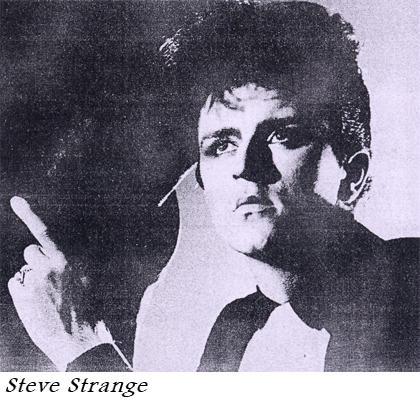 Everyone claims that they were a regular at the Blitz Club. But my claim is real, and I can prove it. I remember queuing outside on the very first night in February 1979 eager to get in. However, to gain admission to the Blitz, I had to pass the strict door test. This meant being fashionably sanctioned by Steve Strange, who was sitting imposingly behind a polished wooden counter as soon as I got my foot through the door.
Everyone claims that they were a regular at the Blitz Club. But my claim is real, and I can prove it. I remember queuing outside on the very first night in February 1979 eager to get in. However, to gain admission to the Blitz, I had to pass the strict door test. This meant being fashionably sanctioned by Steve Strange, who was sitting imposingly behind a polished wooden counter as soon as I got my foot through the door.
A pair of strikingly made up eyes scrutinized me. “Hi, it's two pounds to get in and a pound for membership,” Steve Strange said. I pushed three crumpled green notes over the counter in exchange for a Blitz membership card. Steve graciously motioned towards several stubby pencils, one of which I used to sign the card, while simultaneously thanking my lucky stars.
Inside, the Blitz was scattered with tables adorned with red and white checked cloths and simple fresh flowers. The low lights were coming from candles wedged into empty wine bottles, swollen with cascades of wax that had dried into hard rivulets. Bright lights over the bar were reflecting in the tantalising selection of glass bottles glowing with coloured liquids: primed and ready to be mixed into all manner of mind-blowing cocktails.
The Blue Lagoon
The bar at the Blitz was run by Sue Scadding, a fine-boned Debbie Harry lookalike, who was always sweet and polite. As the Tuesday nights became more popular she brought in her darker haired sister to help her when the bar got really busy. The Blitz was housed just off Southampton Row at the back-end of Covent Garden where the boom in cocktail bars was just beginning. My favourite cocktail was the Blue Lagoon. I loved the bright colour and the bitter taste of the Blue Curacoa, the crunch of crushed ice infusing the flavours of lime, sweet lemonade, and most importantly, the vodka - all converging under a miniature paper parasol.
Drinking alcohol was integral to a good night at the Blitz. So too was dancing and dressing up. And the challenge was doing all three at once. Beyond the bar, to the right of the darkened dance floor, a fresh faced and immaculately dressed Rusty Egan mixed the undulating sounds of hypnotic electronic music. The dance floor was punctuated by several slim iron pillars serving as substitute dance partners when the real thing was either no longer willing or able. Rusty’s broad musical remit made sure that we luxuriated in the eclectic sounds of Warm Leatherette by Grace Jones, No Great Dark Man by Gina X and Roxy Music's Do the Strand.
Outside the Blitz Club at 4 Great Queen Street WC2, the big white neon lights spelling the club’s name was intimidating at first. But once inside, the cafe-blinds and bare floorboards made the Blitz feel intimate, cabin-like, and safe. Fragments of the Second World War memorabilia, like the Ministry of Defence poster instructing a blackout warning to, “Switch Off That Light!” to survive the Nazi’s nightly air raids and the rubber and glass gas masks all adding to the atmosphere. Upstairs you could have your drinks delivered by a dumb waiter from the bar below whilst sitting under the blown-up black and white movie stills of the Hollywood stars.
I was no stranger to the Blitz Club, having been a regular at the Motown 60's night held on Sunday evenings, and also to a friend's private party. So, I was confident that I could find the the loos there. But on Steve and Rusty's Tuesday and Thursday nights, both sexes flocked to the ladies toilets after traversing the spiralling wooden staircase to the basement to apply fresh layers of theatrical facepowder and lipstick.
The New Romantics
One night Steve Strange famously turned away Mick Jagger, a rejection that successfully fuelled the media fascination that was beginning to surround the club. But on that first night I noticed Steve staring at me. He got me thinking: What was my purpose in being allowed in to the Blitz? Did he think I was a boy? Or did he know I was a just a 15 year old schoolgirl? It didn’t matter. I stared back at his arrestingly stylish persona and began tuning in to what the Blitz was about.
I became aware of Rusty rushing around from the dance floor to the door, and the curious parade of people coming in. But there was something else going on. Despite the Blitz being a small club, it had a sense of space where anything could happen as long as it was creative. It was as if a new field was opening up that would coalesce around the new people, new styles, new sounds and Steve himself. I absorbed this unspoken information as Heroes by David Bowie ululated like a siren call across the dance floor. Tingling with excitement, I drained my Blue Lagoon to its last icy drop and decided to embrace the idea of the Blitz.
The philosphy behind the Blitz was a rebellious notion that brought together an eclectic and electric group of people sparking a cultural movement that the press called “The New Romantics”. Our assumption was that we had a part to play in an important place at the appointed time. It was the place where individual fantasies could be expressed and creative visions could be forged. However, in this intensely competitive environment, the collective mission was to conjure something fresh from the ashes of punk rock and tired disco. On any given night I could see Gary Numan, Billy Idol, and one evening I had a good old chinwag with the charming pop-star and actor David Essex.
The Blitz became the glamorous refuge for a milieu of artists, designers, milliners, singers, DJs and writers to assert a colourful and revolutionary antithesis to the Prime Minister Margaret Thatcher's grey Britain. We were taking responsibility for creating an alternative social reality to the recession, race riots, police misdemeanours and political strife.
A common thread connecting the Blitz kids was, and still is, a love of David Bowie and his music. Bowie repaid the compliment in spades by asking Steve Strange to select a posse of Blitz regulars to participate in his video for Ashes to Ashes, a song that perfectly chimed with the sentiments of the New Romantics. One night, I was lucky enough to meet my hero (at Steve and Rusty's other club called Hell) when he asked me for a light for his cigarette. Calming myself, I held my lighter out to him. He leaned in, cupping his hands around my hands and the flame, and inhaled deeply on his cigarette. I smiled demurely at this perfect gentleman and strolled off coolly in a black and white tulle ballgown after Bowie murmured his thanks. But, as soon as I was out of his ambit, I found a private corner where I could emit short visceral screams.
Einstein a -Go-Go
Electronic music was the significant emergent factor underpinning the radical cultural change being created at the Blitz. Gary Numan, an early “electro” ambassador, was often seen dressed in an aviator jumpsuit and eyeliner, cleverly anticipating his future life as a pilot. But then, Numan’s synthesizer driven songs, Are Friends Electric? Cars and I Die, You Die were the unconventional and popular soundtracks of the era. And, when Steve Strange recorded the synth-anthem Fade to Grey with Visage, Britain’s New Romantic club culture went international.
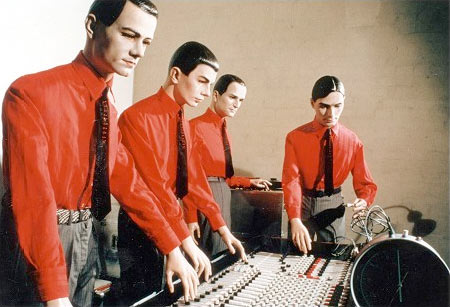 The 1980's dress style strongly nodded towards glamour and romance, recycling and Do It Yourself. In contrast, the production of music was driven by technology. Science was celebrated in song by Thomas Dolby’s She Blinded Me With Science and Landscape’s Einstein a- Go-Go. And, the electro-burlesque musical act Shock featuring duo Tik and Tok’s innovative robotic dance movements expressed the reductive idea that we are made up of parts. There was no doubt that mechanized music was upon us when Telex’s Moskow Diskow came steaming across the Blitz dance floor. Rusty Egan’s playlist was different precisely because he was showcasing the music produced with computer programmed samples and synthesizers with funny names like Fairlight, Moog and Korg.
The 1980's dress style strongly nodded towards glamour and romance, recycling and Do It Yourself. In contrast, the production of music was driven by technology. Science was celebrated in song by Thomas Dolby’s She Blinded Me With Science and Landscape’s Einstein a- Go-Go. And, the electro-burlesque musical act Shock featuring duo Tik and Tok’s innovative robotic dance movements expressed the reductive idea that we are made up of parts. There was no doubt that mechanized music was upon us when Telex’s Moskow Diskow came steaming across the Blitz dance floor. Rusty Egan’s playlist was different precisely because he was showcasing the music produced with computer programmed samples and synthesizers with funny names like Fairlight, Moog and Korg.
Kraftwerk's pioneering use of synthesizers and vocoders created the distinctive robotic vocal sounds and imitative bleeps and burbles heard on seminal songs The Robots, Showroom Dummies, and Trans Europe Express. But away from the structure and uniformity of Kraftwerk, there was a need for a new rebellious rock star to harness the raw energy of the New Wave music scene. Billy Idol from Generation X perfectly fit the criteria. His amazing face had graced the Blitz years before he conquered America with a Rebel Yell and he became the poster boy of a renaissance punk rock.
Spandau Ballet
The Blitz was dominated by good-looking boys, and none were more beautiful than Spandau Ballet. Tony Hadley, who is very tall, strolled around the club declaring that he was the lead singer of a group called “The Gentry, and "We’re going to be famous.” His prophecy came true, but only happened with a quick change of the band’s name. Despite his colossal confidence, we were stunned by the resonance of his powerful voice, and his heartfelt rendition of Gary Kemp’s richly textural songs at the Blitz Christmas party in 1979.
The buzz around the Spandau boys was palpable and we all knew they would be stars. I was lust-struck after a snog on the staircase with Steve Norman, the saxophone player, who is understandably a very good kisser. I recorded the details in my diary, now sadly lost. The following Tuesday night, at a time when my hair colour changed with the weeks, I asked Steve why he had kissed me. He replied, “I thought you were a blonde!”
The Blitz kids faithfully followed Spandau Ballet to the HMS Belfast moored on the River Thames. I slipped aboard the shipshape quarterdeck in my very high heels and long black evening dress embellished with a huge silk waterfall bow that was suspended at my waist with tiny hooks and eyes, and a borrowed white fox-fur stole. The press and film crews showed up in droves and my beautiful friends and I somehow inadvertedly locked ourselves into a cabin for part of the night!
Spandau played the cavernous nightclub Heaven, under the arches in Charing Cross, paring ruffle shirts down to white vests and neckerchiefs. The infectious congas on To Cut a Long Story Short reverberated around the huge space as photographers jumped out of the shadows, shoving flashlights in our faces. It was hot hown there, especially as I had overdressed in a white satin shirt with angel sleeves stuffed into a 1950's frock coat with a wide white leather belt, a big white hat and white gloves.
The Scala Cinema in Soho televised Spandau’s performance for a current affairs programme called Twentieth Century Box. It was a golden afternoon in May 1980, and I had deliberately clashed my pink swing jacket with a pair of green satin stilettos. I waited excitedly for my friend Dick, who later modelled Vivianne Westwood’s memorable pirate collection, to pick me up in his car. Dick was seventeen and already understood how the media worked. When we arrived early at the Scala, he went back outside to make sure that he was filmed coming back in.
DIY Dior
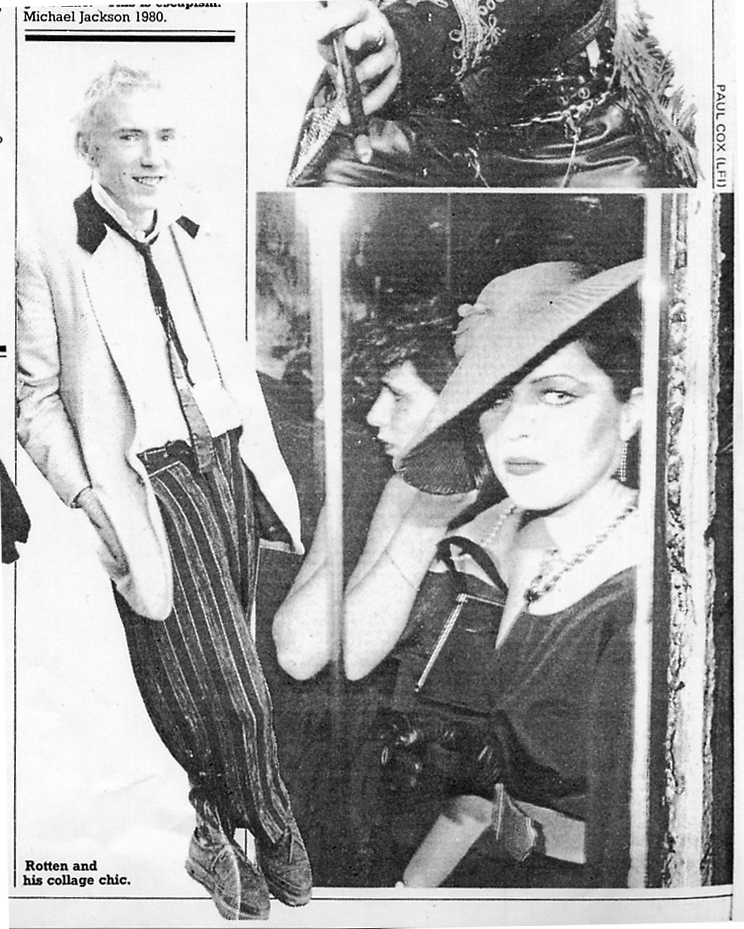 A refugee from war torn Berlin was a key to my Blitz style. She was my elderly next door neighbour, who watched me in the garden from her upstairs window. At first she'd wave and smile and I waved back. Then one day she called me to her front door. There she had put out two lovely old suitcases filled with a beautiful array of silk, suede, leather and lace gloves, leather belts of every width and colour and a clutch of handbags and purses with fabulous clasps. The second suitcase stored her old 1920’s flapper dresses and 1930's suits, t-bar shoes, sparkling berets and small pelts of rabbit and mink fur. She explained that her husband was a furrier in Berlin during the thirties, and that they had to leave for England in a hurry. These treasures were part of her life before the war and she was handing on her elegant legacy to me. I loved her story and her clothes and set about putting them to good use.
A refugee from war torn Berlin was a key to my Blitz style. She was my elderly next door neighbour, who watched me in the garden from her upstairs window. At first she'd wave and smile and I waved back. Then one day she called me to her front door. There she had put out two lovely old suitcases filled with a beautiful array of silk, suede, leather and lace gloves, leather belts of every width and colour and a clutch of handbags and purses with fabulous clasps. The second suitcase stored her old 1920’s flapper dresses and 1930's suits, t-bar shoes, sparkling berets and small pelts of rabbit and mink fur. She explained that her husband was a furrier in Berlin during the thirties, and that they had to leave for England in a hurry. These treasures were part of her life before the war and she was handing on her elegant legacy to me. I loved her story and her clothes and set about putting them to good use.
The Blitz style was all about recycling fashion and creating your own style. There were rich vintage pickings to be had at the Covent Garden antiques market, in the second-hand shops on the cobbled Laines in Brighton, and in the flea market on Portabello Road. Jumble sales on a Saturday were a must, jostling on the front line with the little old ladies, snapping up the best bargains for pennies. It helped that my neighbour Linda, the world’s biggest Clash fan, had a garage full of amazing clothes, and she let me take my pick.
One of my older brothers was working for Angels and Bermans (as it was then), the theatrical costumier, so I sneakily raided his resource, and co-opted his old Harrow School trunk as a treasure chest for my collection of beautiful clothes. It was something of an art pulling an outfit together from all these different strands. My inspiration came from old movies, film and photography books, and most importantly from the people around me.
By January 1981, the hard work was starting to pay off for us young fashionistas when Time Out magazine ran a cover story feature on the New Romantics. I read the article with interest and was surprised to see a prominent photograph of myself amongst the great and the good of fashion and music complete with the caption “DIY Dior or Le Kilt cool? Le Kilt, Billy’s, Club for Heroes, the Embassy, Hell, Planets and the Wag were other clubs with other stories. With a sense of irony the magazine was declaring the New Romantic movement over precisely because Time Out was writing about it.
Schools out
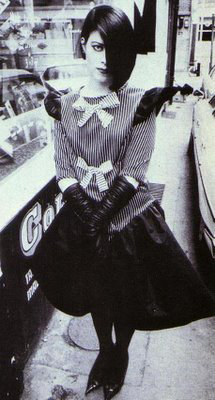 I secretly go to ‘rival’ Studio 21, next to Tottenham Court Road station, on Saturday nights. It was a large subterranean club with a sprung dance floor and a mixed crowd. Run by Jock McDonald and DJ Dave Archer, who attracted a sort of ‘clan’ comprising Richard Jobson and Russell Webb from the Skids, John Keeble from Spandau Ballet, John Lydon from Public Image Ltd, Mark Shaw from Then Jericho and Barry O’Dea, a man from Balham. At one after-party my friend Wendy and I found ourselves sitting cross–legged on the floor of a high-rise apartment with Lydon, aka Johnny Rotten, quoting us the lines: “Little girls with painted faces should be seen and not heard” from X-Ray Spex’s “Oh Bondage, Up Yours!”
I secretly go to ‘rival’ Studio 21, next to Tottenham Court Road station, on Saturday nights. It was a large subterranean club with a sprung dance floor and a mixed crowd. Run by Jock McDonald and DJ Dave Archer, who attracted a sort of ‘clan’ comprising Richard Jobson and Russell Webb from the Skids, John Keeble from Spandau Ballet, John Lydon from Public Image Ltd, Mark Shaw from Then Jericho and Barry O’Dea, a man from Balham. At one after-party my friend Wendy and I found ourselves sitting cross–legged on the floor of a high-rise apartment with Lydon, aka Johnny Rotten, quoting us the lines: “Little girls with painted faces should be seen and not heard” from X-Ray Spex’s “Oh Bondage, Up Yours!”
The Blitz exerted a powerful influence on many of us, particularly because we were so assuredly young at the time. In hindsight, it might have helped my future to have gone to school more often. I remember when Wendy and I scuppered our sixth form chances at 6am in St James's Park by bunking our maths exam later that day after a particularly good night out. Yet, I cannot deny that those incredible nights in London during 1979-81 continue to inform my life in so many ways.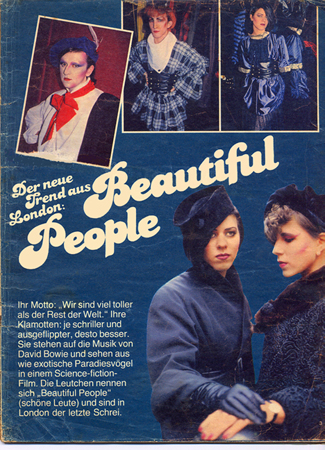
The Face Magazine
The Blitz was home to a carnival of characters, many of whom had cameras, and indulged in taking pictures of each other at various stages during the night. The faces that inhabited these photographs inspired a new crop of magazines: The Blitz, The Face and ID, that people were putting together on kitchen tables and publishing on a shoestring.
In 1980, I was photographed on Carnaby Street wearing amazing outfits designed by Martin Degville, pre-Sigue Sigue Sputnik. I was 16 and a house-model for Vidal Sasson sporting an eye- defying asymmetrical bob. My photos, taken by the Rock photographer Dennis O'Regan, ended up in The Face, issue 9, 1981, and in Madchen, a German magazine, which had sent a reporter to Carnaby Street to find out about who they called ‘The Beautiful People.’ This sort of spontaneous street styling typified the new culture that was influencing fashion and photography from the bottom up.
Another photographer on the punk, skinhead and nightclub scene of the 1970's and 1980's was Derek Ridgers, whose prolific back catologue of photographs has led to the publication of several style books including London Youth 1978-1987, in which I was lucky enough to appear. The Sunday Times Magazine named him one of the top 100 photographers, and today he continues to add to his compelling collection of images of everyday people in the street, great musicians and Hollywood actors.
Thirty years after the Blitz Club in London a Boy George-mad make-up artist Danilo Mozilla, living and working in Brazil, has documented a great many personal and professional photographs as well as artefacts on his Blitz Kids website. It's the world’s first comprehensive online archive of cultural references specifically dedicated to the New Romantic Movement.
Boy George
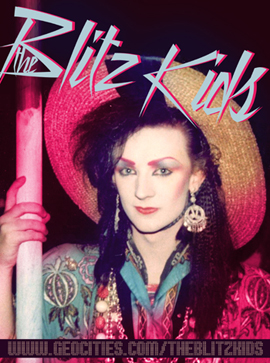 I first met George in 1978 in Birmingham before he added the prefix Boy. He was 16, two years older than me, and we briefly shared a flat some way from the city centre. He was a guest of a blonde skinhead called Mark and I was friends with ‘Gay’ John, who I had met at the David Bowie concert at Earls Court in June earlier that year. I had watched John dancing on Revolver, an ATV pop show directed by the late music impresario Mickey Most in Birmingham, featuring one of Kate Bush’s earliest TV performances and one of Marc Bolan's last. The Birmingham crowd looked like fun and I ran away from my home in London to see John. It seemed to me that George was searching for something too.
I first met George in 1978 in Birmingham before he added the prefix Boy. He was 16, two years older than me, and we briefly shared a flat some way from the city centre. He was a guest of a blonde skinhead called Mark and I was friends with ‘Gay’ John, who I had met at the David Bowie concert at Earls Court in June earlier that year. I had watched John dancing on Revolver, an ATV pop show directed by the late music impresario Mickey Most in Birmingham, featuring one of Kate Bush’s earliest TV performances and one of Marc Bolan's last. The Birmingham crowd looked like fun and I ran away from my home in London to see John. It seemed to me that George was searching for something too.
Inside the close confines of the rattling train carriage returning us to the city, George told me that he wanted to be a singer. I turned away from the dissolving landscape outside the window and the rasp of my Gitane to George’s presence permeating the empty luggage racks and the smoky atmosphere, and asked him, "Can you sing?" He replied by bursting into a medley of Carl Perkins rockabilly tunes. Back then there was something pale about George, and I thought I heard a tad too much vibrato. But everything about the boy from his distinctive voice, his dirty-throaty laugh to his stinging quips, quiff and comments had made an impression. George used the Blitz as a platform on which to fashion his emerging bird-of-paradise persona, and our paths crossed many times back in London.
Phillip Sallon
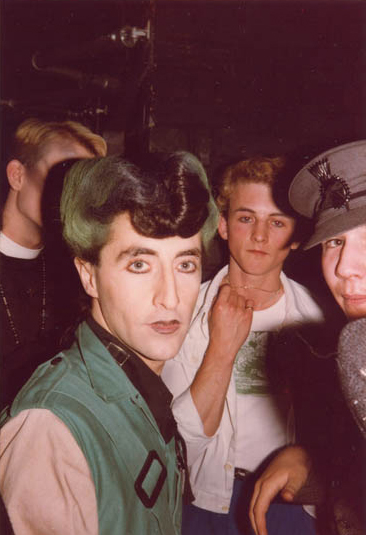 My story cannot ignore Philip Sallon, a larger than life character who crystallized in Boy George’s hit musical Taboo. I first met Phillip at a bus stop in Cricklewood heading towards Golders Green. I was going to the Henrietta Barnett School in Hampstead Garden Suburb and Philip was on his way to work at the Royal Opera House costume department. On the bus I noticed his long curly black hair and lapis blue eyes, and he praised my English rose complexion.
My story cannot ignore Philip Sallon, a larger than life character who crystallized in Boy George’s hit musical Taboo. I first met Phillip at a bus stop in Cricklewood heading towards Golders Green. I was going to the Henrietta Barnett School in Hampstead Garden Suburb and Philip was on his way to work at the Royal Opera House costume department. On the bus I noticed his long curly black hair and lapis blue eyes, and he praised my English rose complexion.
Phillip, who calls everyone “Dear”, stretching out the vowel sounds in an amusing way, asked me questions like “Do you know Tranny Paul?”, and “Are you a lesbian?” whilst barely pausing for breath. At his parents house in Dollis Hill, he delivered a brilliant lecture on the history of fashion with a focus on cross-gender dressing, bringing his subject to life with illustrations. Afterwards, my friend Stephanie and I willingly helped Philip make gefilte fish balls, but his mum didn’t really want us in her kitchen. However, a core of young clubbers relied on Philip's energy and knowledge about what was happening where, who would be there, and what to wear.
Before nightclubs, my social life in North London revolved around punk gigs and parties. I had fallen in love with live music in 1977 at the Marquee club as the thumping sound onstage entered my spirit via the big speakers at the back of the venue. That same year I witnessed Mark Bolan's funeral procession as I skipped home from school down Hoop Lane passing Golders Green Crematorium, as I did everyday. Going through the gates to the Crematorium I saw David Bowie and Steve Harley dressed in demure grey suits. I ran up and said "What's happening?" Steve Harley replied glumly, "It's Marc's funeral." I understood, and a few week later I went to look for Marc's resting place because I couldn't quite believe it had happened. I found it marked Mark Feld 1947-1979. Nowadays, a bench with carved swans commemorates the singer in the crematoriam garden.
Neo Romantics
Places like Billy’s, the pre-eminent club to the Blitz, run by Rusty and Steve, had a velveteen glamour all of its own. The New Romantics happened because of Steve Strange and Rusty Egan, who were 19 when they started the Blitz, and the kids who were working hard to meet the demands that change makes of us all. Nowadays, DIY is a driving force in changing cultures all over the world, but then it was a construct belonging to band of teenagers in a club in Covent Garden.
At the Blitz reunion parties in 2009, and in a state of nicotine-free sobriety, I fully appreciate Rusty’s energy, and the capacity of classic electronic dance music to evoke my favourite 30 year old memories, dreams and emotions. But it is eerie seeing the new faces looking like the ‘old’ faces would have done had they been caught in a 1980’s time capsule. The new generation has morphed into the Neo Romantics and The Face Club. But I reflect on the people that are not there and where I have got to in my life. I had looked forward to giving Tony Hadley and others a hug, and missed seeing so many beautiful people from the first time around at the Blitz.
Blitz Girl
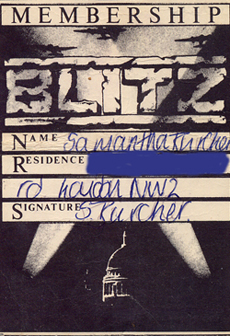 A few weeks later I received an email from Gary Kemp with the subject “Blitz Girl?” and we arranged to meet at the British Library. I arrive early to do some research in the reading rooms upstairs. As I go downstairs, I see Gary perched on the pages of a brass book sculpture doubling as a seat in the public entrance. He is looking fit, handsome and well dressed. And, as he walks towards me, he slings his leather messenger bag further to one side to give me a great big hug.
A few weeks later I received an email from Gary Kemp with the subject “Blitz Girl?” and we arranged to meet at the British Library. I arrive early to do some research in the reading rooms upstairs. As I go downstairs, I see Gary perched on the pages of a brass book sculpture doubling as a seat in the public entrance. He is looking fit, handsome and well dressed. And, as he walks towards me, he slings his leather messenger bag further to one side to give me a great big hug.
I had brought a stack of photo albums from around the time of the Blitz to show him. And so, we enjoyed a relaxing afternoon drinking green tea, looking through the photographs and reminiscing about the ‘old days.’ We talked about the imminent reformation of Spandau Ballet, his growing family, and Gary proudly told me that his eldest son Finn had recently climbed Mount Kilimanjaro, no mean feat for a teenager.
Gary Kemp was only 19 when he and I first met at the Blitz, but by then he had already written some of his award winning, number one, classic songs including True. Gary laughs when I speculate on the blue plaque that will be outside his house in a Fitzrovia of the future. And I wonder if something similar will soon mark the place on Great Queen Street where the Blitz Kids were born.








